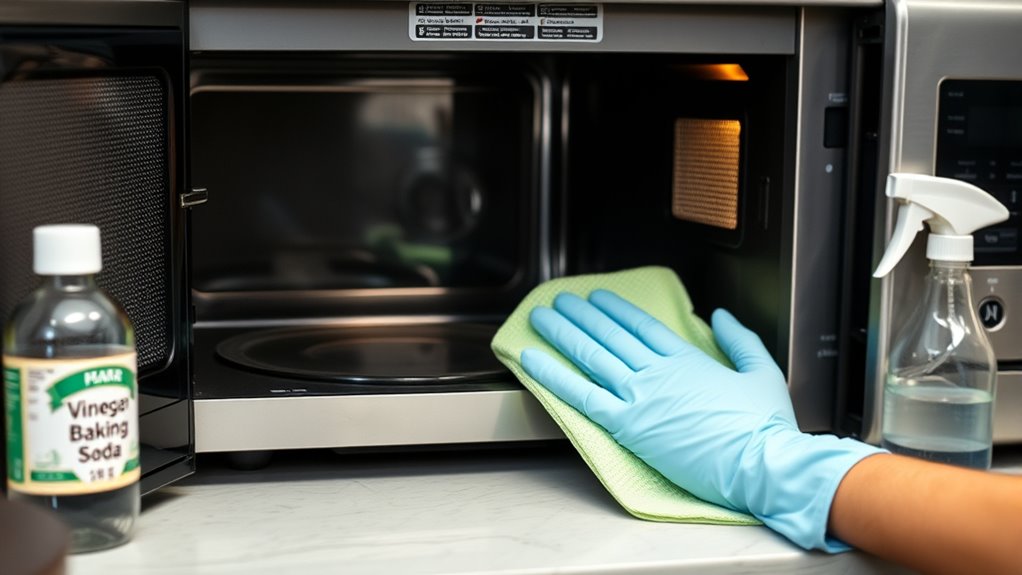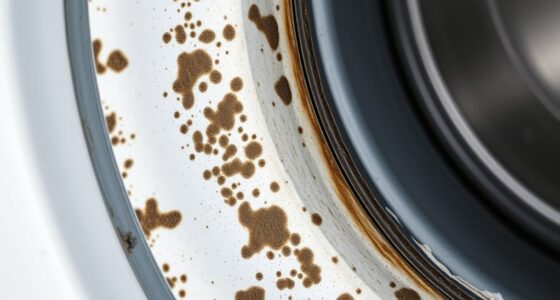To care for your microwave, regularly clean the interior with a damp cloth and a mixture of water and vinegar or mild soap to remove food splatters. Wipe down the exterior and control panel, paying attention to the door seal to prevent buildup. Avoid harsh abrasives and never run it empty or use metal inside. Keeping vents clear and inspecting for damage helps maintain safety. Stay tuned to discover more tips for keeping your microwave in top shape.
Key Takeaways
- Wipe interior surfaces regularly with damp cloth and use mild cleaners for stubborn stains.
- Clean the turntable and support ring periodically to ensure even heating and prevent odors.
- Keep the door seal and exterior vents clean and inspect for damage to maintain safety and efficiency.
- Avoid running the microwave empty, using metal objects, or neglecting signs of malfunction.
- Stay informed about new features and follow updated maintenance routines for optimal safety and performance.

Microwave ovens are a convenient appliance that can last for years with proper care. To guarantee your microwave stays in excellent condition, regular microwave maintenance is essential. By taking simple steps to clean and care for your appliance, you not only keep it functioning efficiently but also extend its overall lifespan. Proper maintenance helps prevent common issues like bad odors, uneven heating, or mechanical failures, saving you money and frustration in the long run.
Start by cleaning the interior regularly. After each use, wipe down the inside with a damp cloth or sponge to remove food splatters and spills. For stubborn stains or greasy buildup, use a mixture of water and vinegar or a mild dish soap. Avoid harsh abrasives or metal scrubbers, as they can scratch the interior surfaces. Don’t forget to clean the turntable and its support ring, since debris can accumulate there and affect the microwave’s performance. Removing and washing these parts every few weeks helps maintain even heating and prevents odors from developing.
Regularly clean the microwave interior, including the turntable and support ring, to prevent odors and ensure even heating.
Cleaning the exterior is just as important. Wipe down the control panel and door with a soft cloth dampened with a gentle cleaner. Pay special attention to the door seal, as grime and food particles can collect there, compromising the microwave’s safety and efficiency. Keeping the door seal clean ensures a proper closure, which is crucial for microwave safety and consistent operation. Regularly inspecting the door for damage or gaps can help you catch potential issues early before they escalate into costly repairs.
Another key aspect of microwave maintenance involves checking the vents and exterior vents for dust or blockages. Proper ventilation prevents overheating and keeps your microwave running smoothly. If you notice strange noises, sparks, or if the microwave isn’t heating evenly, don’t ignore these signs. Unplug the appliance and perform a thorough inspection or call a professional if needed. Proper maintenance minimizes the risk of breakdowns, ensuring your appliance remains reliable and safe to use.
Additionally, staying informed about the latest advancements, such as improved AI technology integrated into modern appliances, can help you choose models with enhanced features that support easier maintenance and safer operation. Practicing safe usage habits contributes to appliance longevity. Avoid running the microwave empty, never use metal objects inside, and always cover food to prevent splatters. Using the microwave correctly reduces wear and tear, preserves its internal parts, and keeps it functioning efficiently for years. Consistent, mindful microwave maintenance is your best strategy to enjoy a safe, efficient, and long-lasting appliance.
Frequently Asked Questions
Can I Use Metal Utensils in My Microwave Safely?
You shouldn’t use metal utensils in your microwave because it compromises microwave safety. Metal can cause sparks, fires, or damage your appliance. Instead, opt for microwave-safe glass or plastic containers. If you accidentally use metal, turn off the microwave immediately and remove the utensil carefully. Always follow microwave safety guidelines to prevent accidents and keep your microwave functioning properly. Remember, safety first when it comes to microwave use.
How Often Should I Replace the Microwave’s Charcoal Filter?
You should replace your microwave’s charcoal filter every 6 to 12 months, depending on your usage and the manufacturer’s maintenance schedule. Regular filter replacement keeps your microwave running efficiently and prevents odors. Check your user manual for specific guidance, and schedule filter maintenance as part of your routine appliance care. If you notice lingering smells or reduced ventilation, it’s time for a filter replacement to guarantee peak performance.
Are There Eco-Friendly Cleaning Alternatives for Microwave Maintenance?
Yes, you can use eco-friendly cleaning alternatives for your microwave. Opt for biodegradable cleaning products or natural disinfectants like vinegar and baking soda, which safely break down grease and grime without harmful chemicals. Simply mix equal parts vinegar and water for a natural cleaner, or sprinkle baking soda inside and wipe with a damp cloth. These methods keep your microwave clean and safe while protecting the environment.
What Should I Do if My Microwave Emits a Strange Smell?
If your microwave emits a strange smell, act quickly—about 60% of odors come from food residue or spills. First, unplug it for safety precautions. Then, use a mixture of baking soda and water or vinegar to odor removal, placing a bowl inside and microwaving for a few minutes. Wipe the interior thoroughly afterward, ensuring no lingering smells and maintaining safe operation.
Is It Safe to Use Vinegar for Microwave Cleaning?
Yes, using vinegar for microwave cleaning is safe if you dilute it properly. Vinegar safety is important, so mix equal parts vinegar and water to prevent damage or strong fumes. It’s effective for cleaning efficacy, as the acidity breaks down grime and odors. Just heat the mixture in a microwave-safe bowl for a few minutes, then wipe clean with a soft cloth. This method is both safe and efficient for maintaining your microwave.
Conclusion
Now that you know how to keep your microwave spotless and safe, imagine what could happen if you neglect these tips. A small spill or overlooked safety measure might seem insignificant—until it isn’t. Stay vigilant, follow these steps, and your microwave will serve you reliably. But beware: the true test of your care is still coming. Will you be prepared when the unexpected finally strikes? The choice is yours—don’t wait until it’s too late.










